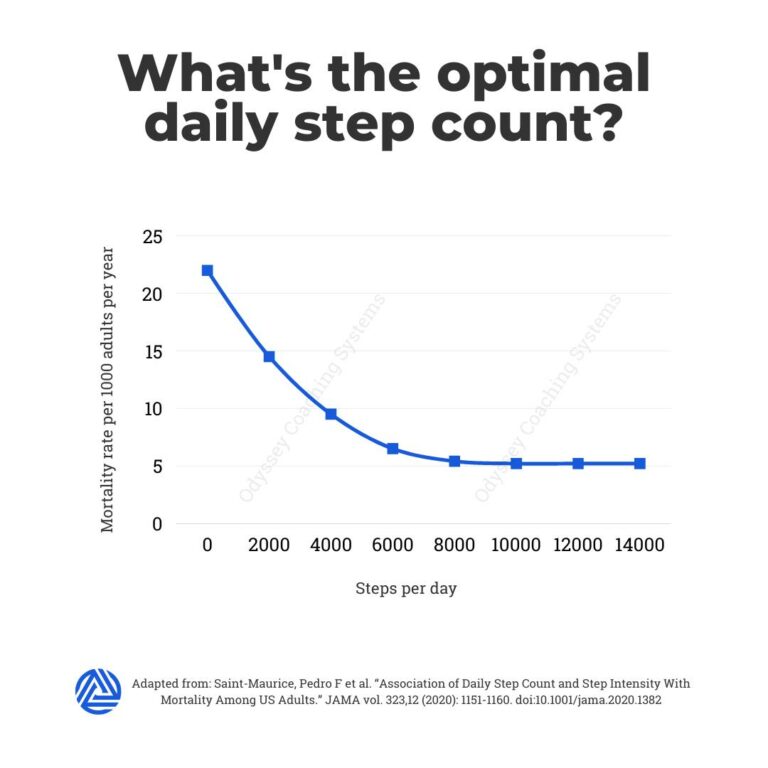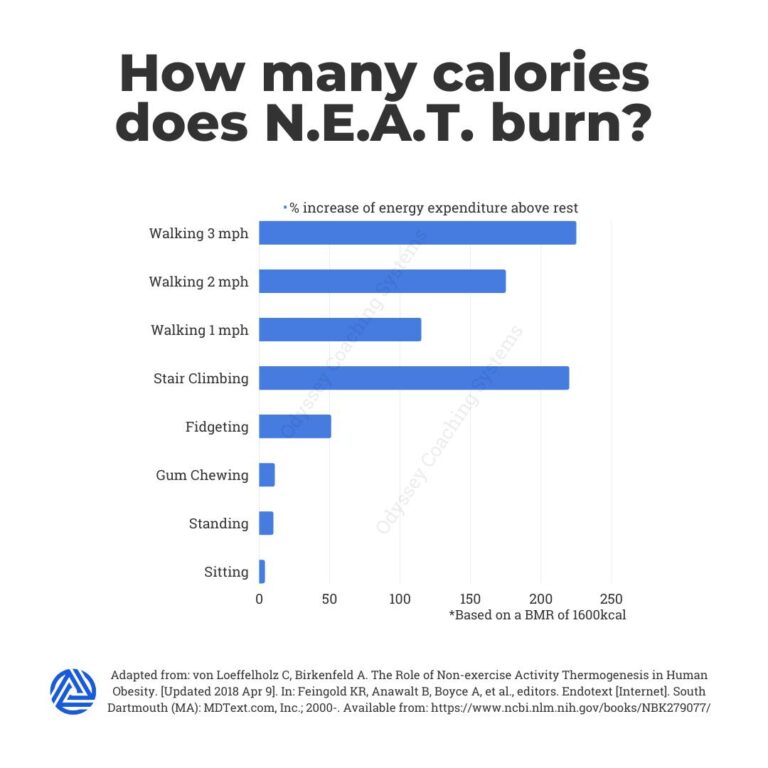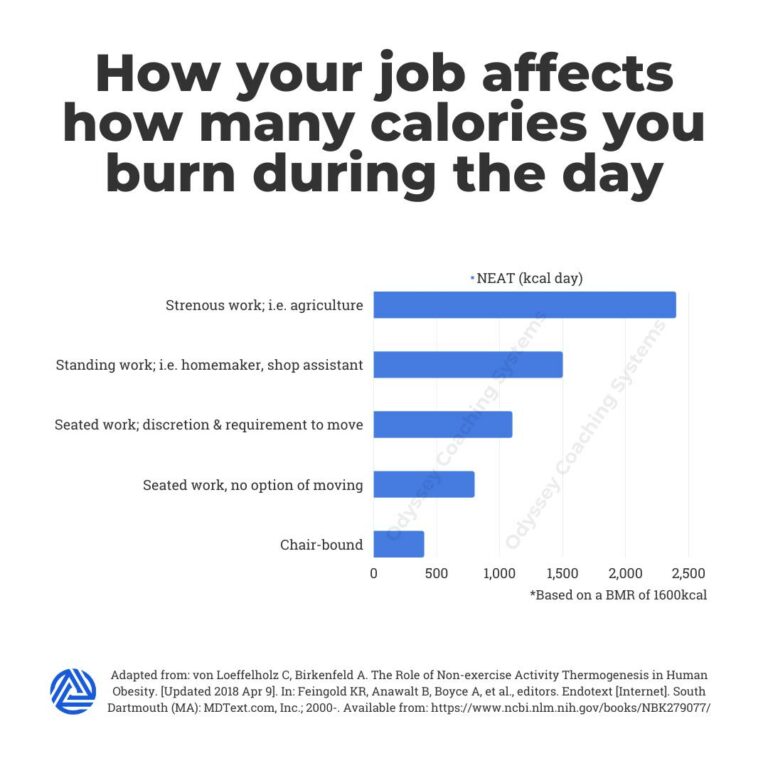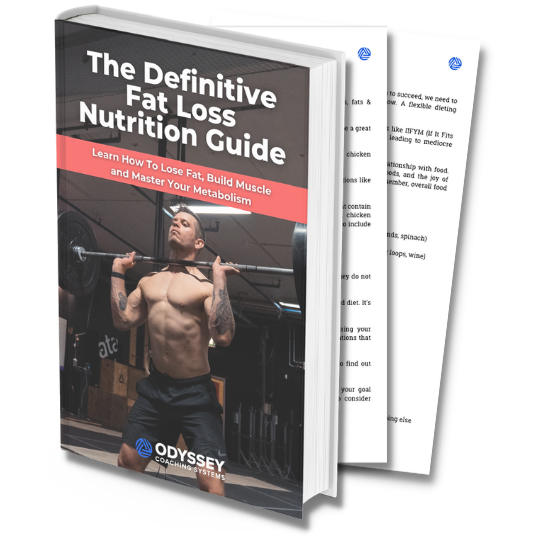Main Take-Aways
1. Increasing NEAT (Non-Exercise Activity Thermogenesis) can help you lose fat and keep it off, improve insulin sensitivity, lower blood pressure, improve blood sugar levels as well as other important health markers like cholesterol levels, manage stress, and more.
2. Non-exercise activity accounts for 15% of your Total Daily Energy Expenditure (TDEE). That’s three times as much as the amount of calories you burn through exercise activity, which averages around 5%.
3. When it comes to adding activity to support fat loss, fat loss maintenance and overall health, you’re probably better off focusing on your step count instead of calories burned through exercise.
NEAT is short for Non-Exercise Activity Thermogenesis, or in plain English; everyday activity.
This includes walking, talking, blinking, sitting, fidgeting.. Basically any type of movement that’s not purposeful exercise like lifting weights, bodyweight workouts, cardio, etc.
While you may think that we mostly burn calories working out, let’s not forget about the 23 hours spent OUTSIDE of the gym. Let’s take that minus the 8h (ideally) spent in bed, and you’re left with 15 very valuable hours .
That’s where NEAT comes into play.
In this article we’ll talk about why non-exercise activity is so important, how many calories NEAT burns and how things like your job have a big impact on your TDEE.
Then last but not least, we’ll talk about the unsung hero of your health and fitness journey.. A true (not-so) secret weapon for fat loss: walking.
Why is NEAT important?
You might be surprised to hear that NON-exercise activity thermogenesis accounts for three times as many calories burned as exercise activity. More on that in a bit.
NEAT is the most adaptive component of your metabolism, and your daily movement will eb and flow in relation to your energy balance [1].
⇒ Read more about your Total Daily Energy Expenditure.
During a fat loss phase your body will adapt by moving a little less to burn fewer calories. You’ll feel more sluggish, are less likely to get up off the couch, and even blink and fidget less. This mostly happens subconsciously.
On the flip side your body will begin to expend more energy when you increase your food intake during a reverse diet, or even go into a calorie surplus to build muscle.
Now the benefits of moving enough/more go far beyond just calories burned.
Increasing NEAT can help you lose fat and keep it off, improve insulin sensitivity, lower blood pressure, and improve blood sugar levels as well as other important health markers like cholesterol levels.
Post-meal walks have been shown to improve digestion, alleviate symptoms of conditions like IBS [2], and help maintain stable blood sugar levels [3].
Going for a walk can also just be a great way to get some de-stressing you-time. Walking in general, but especially in nature [4], seems to lower cortisol, increase dopamine and serotonin, and can put you back into a more parasympathetic state.
Now if that wasn’t enough reason to get moving yet; a morning walk and getting daylight can even help support a healthy circadian rhythm by stimulating melatonin production in the evening. And let’s be honest, who wouldn’t do well with a bit of extra fresh air and vitamin D?
For me personally, going for walks is one of my daily non-negotiables. It brings mental clarity, boosts productivity, helps me brainstorm, and it supports my health and fitness goals.
How many steps a day is healthy?
Tracking your daily steps seems to be the most accurate way to keep track of your NEAT. Although not all non-exercise activity is walking, at least the step count correlates with you moving around. Even if it’s slightly inaccurate, as long as you have consistent data, you can make adjustments.
I overheard someone walking about how the 10000 steps per day thing is pure marketing, which is false.
All the way back in 1965, a Japanese step tracker manufacturer called Manpo-kei (Japanese for ‘10000 steps’), came up with the daily 10000 step goal. Years later in 2009, FitBit launched their first wearable and made it a worldwide phenomenon.
So yes, 10000 steps per day did start out in marketing. However these days we have a lot of research to support that it’s actually a very valid goal that can support your health and longevity.
A 2020 meta-analysis (a study that includes a bunch of different studies) with 4840 participants [5] found that compared to taking 4000 steps per day, taking 8000-12000 steps per day was associated with significantly lower all-cause mortality.
I feel like I have to repeat that..
That means that getting more steps in can possibly help you lower the risk of ALL-cause mortality (‘death from any cause’).
Now there is a limit, so you don’t have to keep adding more and more steps. Notice how that line flattens out around 8000-12000 steps (see down below)? That’s about the sweet spot you might want to work towards. More isn’t necessarily better.

How many calories does NEAT burn?
Non-exercise activity accounts for 15% of your Total Daily Energy Expenditure (TDEE). That’s three times as much as the amount of calories you burn through exercise activity, which averages around 5%.
But how many calories do you actually burn throughout the day based on your occupation? And what about different forms of NEAT?
Let’s have a look.
A 2018 study on the role of NEAT in human obesity [6] included some cool graphs I wanted to include. Note that these amounts are based on a BMR (not TDEE) of 1600kcal, so don’t run with these numbers.
Look at the difference between sitting, standing, and walking!

A lot of macro and TDEE calculators (including ours) will have you plug in things like weight, height, but also your activity level.
That same 2018 study [6] also shows how big of a role your occupation plays. Depending on how much you’re required to sit or move at work, you might just be burning up to 1000-2000 calories more/fewer than someone with a different job.
⇒ Check out our TDEE calculator to get an estimate of your maintenance calories, or check out the weight loss calculator if your goal is to lose fat and you’re ready to get started.

Does non-exercise activity Thermogenesis help weight loss?
By now you’ve seen how much of a difference daily movement really makes. And with three times as many calories burned compared to exercise, it’s obvious that we want to also look at our time spent outside of the gym.
This is where a lot of people make the mistake of doing cardio to burn calories for fat loss. Sure, it counts. And you CAN include some cardio. But at only 5% (on average) of your total calories burned per day [7], it’s just not going to move the needle.
Walking however, can be a great way to crank your NEAT up to help with weight loss.
It’s a parasympathetic movement that can help you manage stress. Which is important since a calorie deficit is already a big stressor on the body.
Walking also comes with a lower risk of muscle loss compared to a ton of cardio, and there’s very little impact on your joints.
So when it comes to adding activity to support fat loss, fat loss maintenance and overall health, you’re probably better off focusing on your step count instead of calories burned through exercise.
Your body prioritizes burning fat for fuel during low intensity movement, and it does so without the stress response that you’d get from doing high intensity exercise. That’s not to say high-intensity movement is bad. Not at all, it’s actually an AMAZING way to get fit and stay healthy.
However if we’re talking fat loss specifically, there’s a better way:
- Create a calorie deficit through nutrition, the ‘calories in’ side of energy balance.
- Aim to get about 10000 steps a day, to support your overall health and keep ‘calories burned’ in a good spot. Side note: pay attention to your daily step count because during a diet it’s common to see your steps drop. Keep ‘em up!
- Then solidify your long term health and fitness goals by lifting weights to build and maintain muscle (always, not just when dieting), and do some cardio or high-intensity training for the many cardiovascular and health benefits that come with it.
How to increase NEAT - Getting your steps up
Walking is one of the easiest ways to increase NEAT, but there are many other ways to get your steps up. Some of the following tips should help you sneak in some extra steps throughout your day.
Take the stairs instead of the elevator/escalator, walk to the store or to work, get off the bus a few stops earlier, park further away when you do take the car, get up and move during calls if your work allows, do a quick 5-10 minute lap after every meal, do stuff around the house like cleaning or gardening, go jump on a trampoline with the kids, practice your backflip, whatever YOU prefer.
Pro tip 1: Find excuses to move (just a little) more whenever you can. That way it doesn’t all have to come down to one longer walk towards the end of the day.
Pro tip 2: If your step count isn’t yet where you’d like it to be, that’s ok! Just start off by adding 500-1000 steps and see how you go. Then only once you hit your new goal consistently, then feel free to add more.
Pro tip 3: This one might sound silly.. But if you’re short on time, just walk a little faster. Now you don’t have to speed-walk your way around the neighborhood. But honestly this has been a big one for me personally.
Time to get moving!
- Levine, James A. “Non-exercise activity thermogenesis (NEAT).” Best practice & research. Clinical endocrinology & metabolism vol. 16,4 (2002): 679-702. doi:10.1053/beem.2002.0227
- Johannesson, Elisabet et al. “Physical activity improves symptoms in irritable bowel syndrome: a randomized controlled trial.” The American journal of gastroenterology vol. 106,5 (2011): 915-22. doi:10.1038/ajg.2010.480
- Bellini, Alessio et al. “The Effects of Postprandial Walking on the Glucose Response after Meals with Different Characteristics.” Nutrients vol. 14,5 1080. 4 Mar. 2022, doi:10.3390/nu14051080
- Kobayashi, Hiromitsu et al. “Combined Effect of Walking and Forest Environment on Salivary Cortisol Concentration.” Frontiers in public health vol. 7 376. 12 Dec. 2019, doi:10.3389/fpubh.2019.00376
- Association of Daily Step Count and Step Intensity With Mortality Among US Adults
- von Loeffelholz, Christian, and Andreas Birkenfeld. “The Role of Non-exercise Activity Thermogenesis in Human Obesity.” Endotext, edited by Kenneth R Feingold et. al., MDText.com, Inc., 9 April 2018.
- Trexler, Eric T et al. “Metabolic adaptation to weight loss: implications for the athlete.” Journal of the International Society of Sports Nutrition vol. 11,1 7. 27 Feb. 2014, doi:10.1186/1550-2783-11-7





